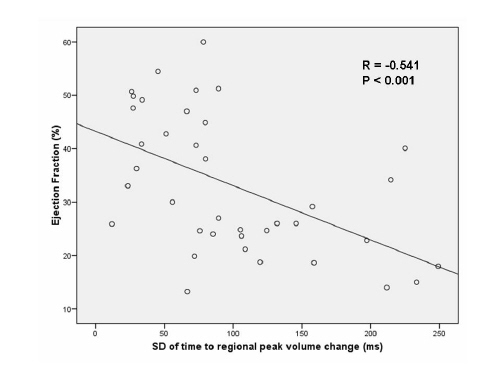| ЙпЧЅЧќНФ : БИПЌ
|
СЂМіЙјШЃ - 510714 33 |
| Comparison of Ventricular Dyssynchrony Assessment in Patients Who Received Cardiac Resynchronization Therapy Using Sequential Biventricular Pacing |
| ъАэЈыІыэ ьъГМыэ ьэъИАыДъГМ |
| ьЅьБь, , ъЙьЇэ, ь ьАьЙ, ьЇьЙь, ьЄьЉь, ьЄэИьЄ, ьДыЇь, ь ьБьБ, ы
ИээИ, ъЙьЌэ, ьЕъЗыГД |
Background:
Cardiac resynchronization therapy (CRT) improves left ventricular (LV) synchrony as evaluated by various echocardiographic parameters. Modulation of VV delay in sequential biventricular pacing (BVP) has been known to result in significant hemodynamic changes. The aim of this study was to evaluate the relationship between left LV ejection fraction (LVEF) and parameters of LV mechanical dyssynchrony (LVMD).
Methods:
Seven patients with heart failure who received CRT were studied. Pulsed tissue Doppler imaging, strain rate imaging, and real-time 3D (RT3D) echocardiography were used to measure standard deviation of 1) time to peak systolic myocardial contraction (Ts-SD), 2) time to peak strain rate (Tsr-SD), 3) time to peak regional volume changes (Tv-SD) in six basal and six mid-LV segments. In each patient, Ts-SD, Tsr-SD, Tv-SD, and LVEF were obtained during sequential BVP (6 different intervals). Totally, 42 echocardiographic data were analyzed.
Results:
Tv-SD was correlated inversely with LVEF (r = -0.541, p < 0.001). However Ts-SD (r = 0.255, p = 0.122) and Tsr-SD (r = 0.308, p = 0.060) showed no significant relationship with LVEF.
Conclusion:
The present study demonstrated that Tv-SD was closely related to LVEF. Dispersion of regional volume change measured by RT3D echocardiography could be a useful parameter for LV systolic function as well as LV dyssynchrony.
|
|
|
Warning: getimagesize(/home/virtual/circulationadmin/htdocs/econgress/conference/abstract/img_files/Resize_CRT3DSD.jpg) [function.getimagesize]: failed to open stream: No such file or directory in /home/virtual/circulationadmin/new/econgress/conference/manage/schedule/view_abstract.php on line 164

|
|





